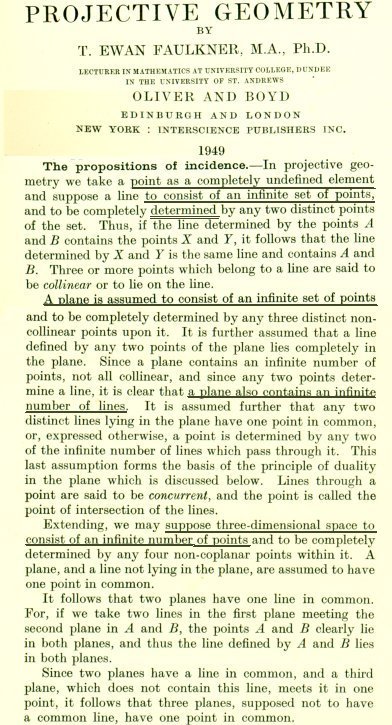Elements (1)
On the Elements
below left, probably represents received projective-geometric wisdom. Just before the quoted passage, the author wrote, of points, lines and planes,
“We make no attempt to define these concepts, ... ”
I attempt it, however, and I query, too, some of the assumptions, as they have tacit “sub-assumptions” that do not survive scrutiny. These appear to be Euclidean notions, carried over and then misapplied.
I have underlined the statements with which I would take issue.
Further to the question of what it means for something to exist, and yet be undefined, perhaps Mr. Faulkner's intention was to bring out that an undefined item is original, independent, stand-alone. That is, one not assembled from other, more primitive things. If this was the intention, I have no quarrel with it.
For example, common sense says that parallels can't meet, but, by unassailable logic, they do. The deeper problem is not whether parallels meet, but whether they exist at all.

is an interval,
and because any size of any kind,
must be an interval,
Geometric elements
do not have size,
It is exactly that simple.
It follows that no element is a quantity
– certainly, none is a number –
each must therefore be a quality.
A point, for example, is just a place, a “somewhere”. Place is its quality. A place is not an interval, so has no size - not even zero.
So a point is not “undefined”: it is defined as place, but named as 'point'.
And it must also follow that no element can “consist” of any other, in whatever number, because,
- by definition, ‘elements’ are not composite
(they are, in fact, atomic – that is to say, uncuttable.
They cannot be broken, and cannot have parts).
To say an element consists, or is composed, of anything, is a contradiction, and a serious logical error [ ** ].
Anything that 'consists' of something else is simply not an element: it is a composite—ultimately, of elements.
- qualities are not the quantities they would need to be in order to be summed, stacked, or aggregated (integrated) into something else—into a line, say, or a plane—as per Mr Faulkner's assumptions, left.
Infinitesimals are absolute, calibrated intervals that must stop just short of zero, because not even an ∞∞ of zeroes will sum to a non-zero value.
No doubt, if points were infinitesimals, they could be summed into lines or planes, so that these elements would ‘consist’ of them – but points are not infinitesimals.
Such “Euclideo-Newtonian” concepts are commonly, but wrongly, tacit in treatments such as Faulkner's of the elements.
Elements
The sizeless, unique qualities of the three, true, geometric elements are as follows—- Place - named as Point
- Extension - named as Line
- Spread - named as Plane.
Elements(2).
* An interval requires two elements of the same type, spanned (linked) by an element of another (appropriate) type, so every simple interval always involves three elements.
Thus, for instance,
- two points must be linked by a line, and
- two lines must be linked by a point, or
- two lines must be linked by a plane, and
- two planes must be linked by a line.
In other words, projective intervals must have valid conditions of incidence.
So, for example, one point on a line, or one line in a point, does not form an interval, but two points, A and B, say, on a line, or two lines, a and b, say, in a point, make two intervals, (1) and (2), say, distinguished by sense:
← ← (2) ← A,a → (1) → B,b ← (2) ← ←
That is, we may reach B/b from A/a either by proceeding left, or anticlockwise from A/a,
on interval (2)
or by
proceeding right, or clockwise from A/a
on interval (1),
on the element that 'spans' them
(a line for points A, B, or a point for lines a, b).
Right and left, clockwise and anticlockwise, are senses, not directions.
Iff such intervals can be conflated with number (metricised) such that distinct intervals can be made absolutely equal (unitised/calibrated), and if such intervals can be summed, then serially contiguous intervals of type 1, in the list above, sum to distance, and those of type 2 sum to angle.
We see that the calibrated interval between two planes in a line (type 4
above) is not
an angle, because an angle is the calibrated interval between two lines in a point (type 2 above), so serially contiguous intervals of type 4 sum to what might be termed "turn" or, perhaps, "swing".
It is often referred to as "dihedral angle", but this is
not entirely satisfactory.
None of these conditions is native to geometry, so we rather refer to intervals in
terms of what they in fact are. We have -
- interpunctual intervals—each having two end-points incident in a line
- interlinear intervals—each having two end-lines incident in a plane and a point
- interplanar intervals—each having two end-planes incident in a line